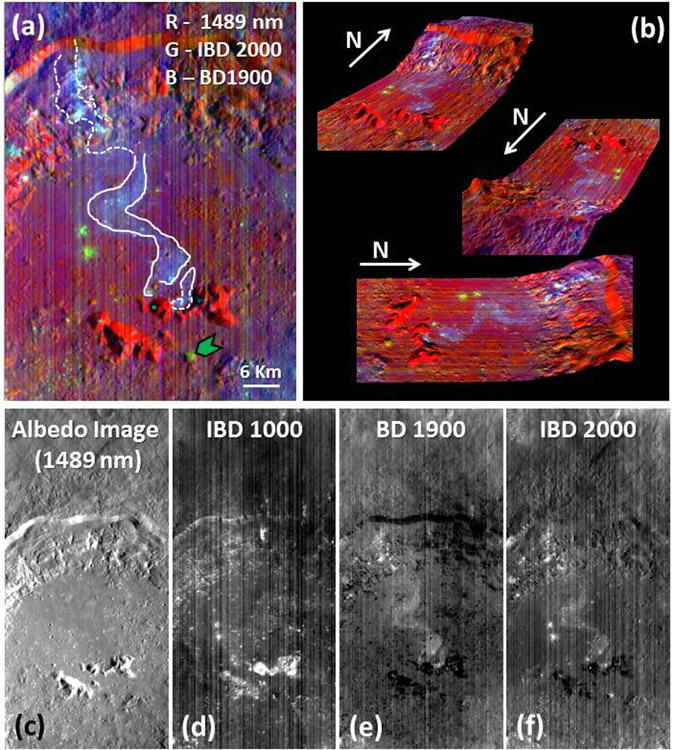March 29, 2013
Melt Ribbon

illustration from Deepak Dhingra, Carle M. Pieters, James W. Head, and Peter J. Isaacson (2013)
We have learned a tremendous amount about impact craters since the 1960s. Gene Shoemaker figured out the mechanics of impact crater formation and the ballistics of ray emplacement. Studies of terrestrial impact craters such as Manicouagan in Canada demonstrated that vast volumes of impact melt are generated at large craters and, surprisingly the melt homogenizes the various compositions of target rocks. Planetary scientists were happy with their understanding. But now with data from an instrument flown on the Indian Chandrayaan-1 lunar orbiter we are discovering that cratering doesn't completely work the way we thought. Yes, impact craters are formed in general the way we have understood, and lots of melt is produced, but it isn't all homogenized. This is shown in the top images from a brand new publication by graduate student Deepak Dhingra and his colleagues at Brown University. The area shown is the northwest quadrant of the interior of Copernicus, which is largely covered by fairly smooth terrain that is a massive deposit of melt. The color composite images (a & b) were made from the individual images in visible (#c) and infra-red (e & f) wavelengths acquired by the Moon Mineralogy Mapper (M^3) on Chandrayaan-1. Images e and f clearly show a bright sinuous patch on the floor and wall that are difficult or impossible to see on image d and the visible light image c. Because M^3 acquired image strips in 83 wavelengths for this area, spectra can be derived, which demonstrate that the sinuous melt deposit is mineralogically different from the more massive melts it sits on. The massive melt has mineralogy similar to basalts such as underlie Copernicus, and the sinuous melt is more like a rock called norite that is believed to make up the upper crust under the basalts. The melt deposit may have been ejected as a ribbon of melt that landed on the floor and wall, and some of the wall melt appears to have flowed back down to the floor. The fact that the norite melt is on top of the basalt-derived melt is consistent with the mechanics of the excavation stage of an impact, where deepest materials come out last. And the central peak, which other studies have found to contain olivine, apparently brought up material from below the norites. Deep crustal stratigraphy on a crater floor.
Chuck Wood
Related Links
Rükl plate 31
21st Century Atlas chart 22.
Deepak Dhingra, Carle M. Pieters, James W. Head, and Peter J. Isaacson (2013) Large mineralogically distinct impact melt feature at Copernicus crater – Evidence for retention of compositional heterogeneity. GEOPHYSICAL RESEARCH LETTERS, VOL. 10, 1–6, doi:10.1002/grl.50255, 2013.
Yesterday's LPOD: Reading the Rocks
Tomorrow's LPOD: Seeing Wrong
COMMENTS?
Register, Log in, and join in the comments.



